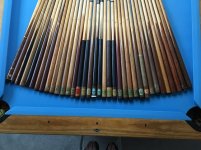A lot of the feel in older well made cues has as much to do with the wood available back then as anything else- maybe more so than anything else. I rarely see any cues being made today with the wood density of cues from many years ago, some may dispute that; but you can look at a lot of cues or even wood baseball bats from the 20s thru the 60s and I definitely see a difference in the woods.
Straight grain maple was a tighter grain in general years ago, the eyes in Birdseye Maple were smaller, tighter and more dense years ago, ebony was heavier and also more dense - ash and hickory as well - if one cannot see it in older pool cues- just pick up a pro baseball bat from, say the 1930s or 40s - rap your knuckles against the wood bat barrel - the wood is as hard as concrete.
Your appreciation for these older cues is so refreshing to hear - I enjoy the art of cue making and it's final products just about as much as playing the game itself - there are not too many sports where hand made equipment in custom shops can present themselves as a hobby by itself - music and it's associated instruments can also fall into this category of performance and appreciation for the tools of the trade.
I have sometimes picked up some very inexpensive cues that played fantastic- way above expectations- it was not because the construction technique was any different from the entire batch, it was because that one cue out of maybe thousands in a run had unique wood properties.
